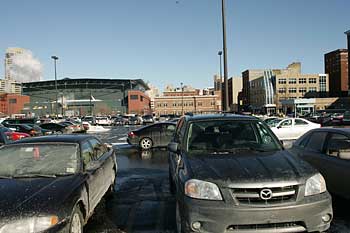It’s been said that Grand Rapids doesn’t have a parking problem--we have a walking problem, and people just can't park close enough to where they want to go.
The City of Grand Rapids owns and/or operates approximately 10,000 parking spaces:
- 4,000 ramp parking spaces in CenterCity.
- 800 surface parking spaces in CenterCity and surrounding neighborhoods.
- 2,000 spaces in two Downtown Area Shuttle (DASH) lots located south and west of CenterCity.
- 2,400 on-street metered spaces throughout the metro area.
 These numbers do not include privately owned lots such as those managed by Ellis Parking, the Amway Grand Plaza Hotel, Bridgewater Place, Grand Rapids Community College, and others. The city does not keep an accurate count of these spaces, meaning there's limited public data on the total number of spaces citywide.
These numbers do not include privately owned lots such as those managed by Ellis Parking, the Amway Grand Plaza Hotel, Bridgewater Place, Grand Rapids Community College, and others. The city does not keep an accurate count of these spaces, meaning there's limited public data on the total number of spaces citywide.
The issue of parking need has come up recently in public forums as some local leaders push to add additional parking capacity on vacant lots awaiting development.
The city's DASH shuttle service carries an estimated 2,000 people per day from parking lots on the perimeter of CenterCity to downtown said Pam Ritsema, Grand Rapids parking system director.
“Rather than having 2,000 passenger vehicles entering downtown, we have ten DASH buses spread out along the route,” Ritsema said.
That still leaves about 8,000 city-owned and operated parking spaces and an untold number of private spaces waiting for cars to occupy them on any given day.
The city's CenterCity lot, tor example, includes 4,000 ramp spaces, 2,600 of which are leased by corporations. That leaves 1,400 available for downtown visitors.
"On February 13, we had 545 visitors parked downtown at the peak hour between noon and 1 PM," Ritsema said. "A total of 2,400 visitors parked downtown throughout the day."
In other words, out of 1,400 visitor parking spots, 855 were empty on a non-event day during peak usage. Even more are empty during off-peak hours.
Portland, Oregon, a city nationally recognized for its revitalization strategies, purposely limits parking within its downtown.
“Paid parking allows us to use pricing as a tool for managing the number of cars downtown,” said Roland Chlapowski, senior policy director for Portland City Commissioner Sam Adams, who heads the city's transportation office. “We use paid parking to discourage unnecessary car trips. We get positive feedback from businesses because paid parking promotes customer turnover; people can’t afford to park in a spot and leave their car there all day.”
“We’ve tried to make our downtown a place where people want to live,” Chlapowski said. “If you can get people to live closer to where they work, you cut down on traffic right away, but you retain the vitality of having people there.”
Grand Rapids generates nearly $10 million in annual revenue from parking, including fines. It's dubious whether that revenue outweighs the combined costs of time spent stuck in traffic, pollution, limited customer turnover, and the massive amount of land area dedicated to surface lots.
Source: Pam Ritsema, Grand Rapids Parking System; Roland Chlapowski, City of Portland
Photograph by Brian Kelly
Enjoy this story?
Sign up for free solutions-based reporting in your inbox each week.